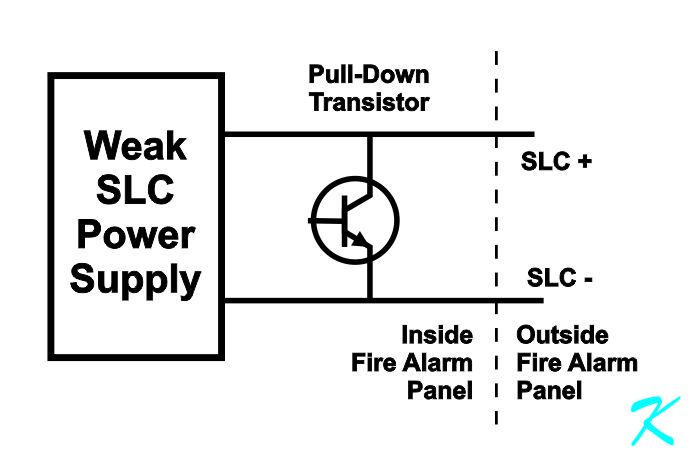Quick Short of 24-Volts onto the SLC
Yes, I, too, have connected wires creating a short. Many times, I, or people I worked with, only had a single spark to indicate a wire brushed against something it shouldn't have. . . but that was enough. Lots of damage can happen with even a quick short on an electronic circuit.
Always keep in mind that all electronics are fragile. Even a short that's a thousandth of a second long can easily punch a small hole through a silicon junction, like the two junctions that can be found in every PNP or NPN transistor. There are many times that a brief spark has required many hours of troubleshooting to repair.
I make mistakes, the installation technician makes mistakes, you make mistakes. Experience, though, is learning from one's mistakes. The installation technician is now a better technician because the technician is now more experienced.
Shorting Transistor
The technical term for the shorting transistor is a Pull-Down Transistor; the transistor pulls down the voltage of the source. In this case, the source of voltage is a very weak power supply. Pulling down the voltage is what the pull-down transistor does, no matter what kind of transistor it is.
I've troubleshot electronic circuits for over half a century now. During almost all of that time, in order to really determine if a transistor is good, the transistor has to be removed from the circuit and tested without the other parts of the circuit interfering with the test. With the miniature components and wiring on the printed circuit board, only the manufacturer has the equipment to safely remove and replace the transistor.
The transistor could have failed open, or the transistor could have failed shorted. If the transistor is still in the circuit, even an ohmmeter probably will not give any definitive indication.
The best you can do is try a different printed circuit board. If the new one works, but the old one doesn't work, then use the new board.
Use a Voltmeter
Before connecting the SLC to the new panel, though, use both an AC and a DC meter on the wires of the SLC. Make absolutely certain that the SLC won't also burn out the new panel. If I was troubleshooting, I'd do that to give me confidence.
Addressable Device Pull-Down Transistor
All addressable devices, all smoke detectors, all heat detectors, all input modules, all supervised output modules, and all control relay modules have this pull-down transistor. When the devices like smoke detectors or modules send signals back to the panel, they don't continuously short out the circuit like a conventional pull station, they rapidly short out and un-short out the SLC creating digital information. They provide short bursts of computer style words so other devices and the panel can also use the SLC to send signals.
It's during those short bursts of rapid shorting of the SLC that the transistors can burn out from the 24-volt power supply. During the brief time that the 24 volts was connected, though, it could easily have shorted out one, some, or all of the pull-down transistors in the addressable devices.
I've never been able to properly use an ohmmeter to determine if an addressable detector is bad. There's just too much circuitry involved inside the addressable device to use the meter.
Very Weak SLC
Especially with EST's SLC, even one pull-down transistor that failed as a short will keep the SLC from working at all. The SLC will show a steady zero volts.
When the SLC shows a steady zero volts, the panel can't use any signals to enquire any device, and no device can respond to a query. In essence, when the SLC is at zero volts, the SLC is dead.
Normally, the SLC provides as a very unsteady reading that jumps around anywhere from 11 volts to 20 volts on the voltmeter. When making measurements on the panel, though, whether or not there're any wires in the terminals, the screws have to be tight. Loose screws on the terminals give false low readings when connecting the voltmeter probes.
If the SLC seems to be shorted, try this. When the panel is programmed and working, and without any wires on the terminals of the SLC in the panel, the measured voltages should be that unsteady 11 to 20 volts. If the voltage drops to zero when the SLC is connected, the panel thinks there's a short.
This "short" could be a device that has it's + and - wires reversed, the "short" could be a wire-to-wire short, or the "short" could be a bad addressable device. This is a very weak power supply, so it doesn't take much to short it out. Once the panel does detect a short on the SLC, the panel will electronically disconnect the SLC for a bit, just to make sure the short won't do any damage.
Wait for the Voltage to Return
Often times, when the panel has detected a "short" on the SLC, the panel won't even try to electronically connect the SLC for the next :30 seconds to a minute. Just wait for it, the panel will try again soon.
Douglas Krantz
